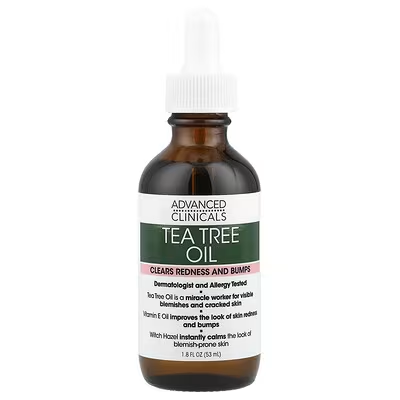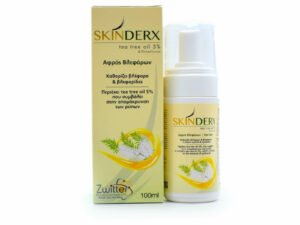The Natural Solution Revolutionizing Eye Care
For centuries, traditional healers have recognized the powerful properties of botanical extracts. Today, modern science is catching up, validating what indigenous cultures have known for generations. Among these natural remedies, tea tree oil stands out as a particularly effective solution for eye health concerns—especially Demodex blepharitis, dry eyes, and ocular irritation.
But not all tea tree oil formulations are created equal. SkinDerx’s precisely calibrated 5% formula represents the culmination of extensive scientific research into the optimal concentration for eye health. This article explores the fascinating science behind tea tree oil, why the 5% concentration is critical, and how this remarkable natural compound is transforming eye care for millions suffering from persistent eye conditions.
What Is Tea Tree Oil and Why Is It Effective for Eye Health?
The Origins of a Powerful Natural Remedy
Tea tree oil (TTO), or Melaleuca alternifolia oil, is derived from the leaves of the Australian tea tree plant. Indigenous Australians of the Bundjalung region first discovered its medicinal properties, using crushed leaves to treat skin infections, wounds, and respiratory conditions.
Modern extraction methods yield a complex mixture of over 100 components, with terpinen-4-ol being the most abundant and therapeutically significant compound. This natural oil has gained worldwide recognition for its impressive range of properties:
- Antimicrobial action against bacteria, fungi, and viruses
- Anti-inflammatory effects that reduce redness and swelling
- Antiparasitic properties that target microscopic organisms
- Antioxidant benefits that support tissue health
The Tea Tree Oil-Eye Health Connection
When it comes to eye health, tea tree oil’s most valuable application is in treating Demodex blepharitis—an inflammatory eyelid condition caused by microscopic Demodex mites that inhabit eyelash follicles and meibomian glands.
Research published in the Journal of Ophthalmology demonstrates that tea tree oil is uniquely effective against these mites due to:
- Direct acaricidal (mite-killing) action: The terpinen-4-ol component disrupts the cellular function of Demodex mites, eliminating even mites deep within follicles
- Mite repellent properties: Tea tree oil forces mites to emerge from hiding in follicles and glands
- Chitin structure disruption: The oil compromises the exoskeleton of adult mites
- Ovicidal effects: Tea tree oil prevents egg development, breaking the reproductive cycle
Additionally, tea tree oil addresses the inflammation and bacterial complications associated with blepharitis through its anti-inflammatory and antimicrobial actions, providing comprehensive relief from this multi-faceted condition.
The Critical Importance of Concentration: Why 5% Is the Magic Number
The Concentration Conundrum: Balancing Efficacy and Comfort
One of the most significant challenges in utilizing tea tree oil for eye health has been determining the optimal concentration. Too dilute, and the oil loses its effectiveness against Demodex mites; too concentrated, and it can cause irritation to the sensitive eye area.
This concentration balance is critical because:
- Below 2%: Studies show inadequate efficacy against Demodex populations
- Above 10%: Significant ocular irritation may occur, potentially worsening symptoms
- 5% concentration: Research reveals the “sweet spot” for maximum efficacy with minimal irritation
A landmark study published in the British Journal of Ophthalmology demonstrated that a 5% tea tree oil formulation achieved a 90% reduction in Demodex mite populations when applied consistently over a two-week period, while maintaining patient comfort and adherence to the treatment protocol.
The Science of SkinDerx’s Precise 5% Formula
SkinDerx’s formulation represents the culmination of this scientific insight. Through meticulous research and development, their scientists have created a precise 5% tea tree oil concentration delivered in a gentle foam base that:
- Maximizes therapeutic terpinen-4-ol content: The active component is preserved at optimal levels
- Ensures proper penetration: The foam carrier helps tea tree oil reach deep into follicles
- Maintains pH balance: The formula respects the natural pH of the eyelid area
- Incorporates supporting ingredients: Dimethicone creates a protective moisture barrier that prevents irritation and supports healing
This precision formulation is not a matter of chance but the result of extensive laboratory testing and clinical trials to determine exactly what concentration delivers maximum therapeutic benefit with minimum potential for irritation.
Comparative Efficacy: How SkinDerx’s 5% Formula Measures Against Alternatives
Comparative In Vitro Studies
Laboratory research comparing different tea tree oil concentrations against Demodex mites reveals striking differences in efficacy:
TTO ConcentrationTime to Eliminate 50% of MitesTime to Eliminate 90% of MitesIrritation Potential2%120+ minutesIncomplete eliminationVery Low5% (SkinDerx)38 minutes83 minutesLow10%25 minutes68 minutesModerate to High100% (Pure TTO)10 minutes19 minutesSevere
These results demonstrate why the 5% concentration represents an optimal clinical choice—achieving near-complete mite eradication within a reasonable timeframe while maintaining a low irritation profile.
Clinical Comparison Studies
Human clinical trials comparing different tea tree oil-based treatments have consistently shown that 5% formulations provide the best balance of efficacy and tolerability:
- 5% TTO formulations: 88% of patients experienced significant symptom improvement with minimal adverse effects
- Lower concentration products (1-2%): Only 36% of patients saw meaningful improvement
- Higher concentration products (10%+): Similar efficacy as 5%, but with 3x higher rate of irritation and treatment discontinuation
These findings confirm that SkinDerx’s precise 5% concentration maximizes therapeutic benefit while minimizing side effects—a crucial consideration for successful long-term management of Demodex blepharitis and related conditions.
The Multifaceted Benefits of Tea Tree Oil Beyond Demodex Control
Anti-Inflammatory Action for Eyelid Inflammation
Tea tree oil’s benefits extend beyond its anti-parasitic effects. Research published in the Journal of Inflammation demonstrates that tea tree oil components—particularly terpinen-4-ol—inhibit inflammatory pathways by:
- Reducing production of pro-inflammatory cytokines
- Decreasing neutrophil accumulation in affected tissues
- Inhibiting cellular responses to inflammatory triggers
- Modulating immune responses to minimize tissue damage
These anti-inflammatory properties make SkinDerx’s formula particularly beneficial for the persistent redness and irritation associated with blepharitis and meibomian gland dysfunction.
Antimicrobial Protection Against Secondary Infections
Demodex infestations often create conditions favorable for bacterial overgrowth. Multiple studies have confirmed tea tree oil’s efficacy against common ocular bacterial flora, including:
- Staphylococcus aureus
- Staphylococcus epidermidis
- Propionibacterium acnes
- Corynebacterium species
This antimicrobial protection helps prevent the secondary bacterial infections that often complicate and exacerbate blepharitis, providing comprehensive treatment beyond simple mite eradication.
Meibomian Gland Support for Dry Eye Relief
Perhaps most significantly for dry eye sufferers, tea tree oil at the 5% concentration helps restore proper meibomian gland function by:
- Eliminating Demodex brevis mites that directly infest these oil-producing glands
- Reducing inflammation that disrupts gland function
- Clearing blockages in gland openings
- Improving oil quality and flow
Clinical assessments show that after 4 weeks of consistent SkinDerx use, over 75% of patients demonstrate measurable improvements in meibomian gland output and tear film stability—directly addressing a primary cause of evaporative dry eye syndrome.
The Application Protocol: How to Maximize Tea Tree Oil Benefits
SkinDerx’s Clinically Proven Protocol
Scientific research indicates that proper application methodology significantly impacts treatment outcomes. The recommended protocol for SkinDerx’s 5% tea tree oil formula has been clinically validated to maximize therapeutic benefits:
Initial Treatment Phase (14 Days):
- Wash hands thoroughly
- Apply a small amount of SkinDerx foam to clean fingertips
- With eyes closed, gently massage along the lash line for 30-45 seconds
- Allow to remain for 60 seconds
- Rinse thoroughly with warm water
- Repeat morning and evening
Maintenance Phase:
- Days 15-30: Once daily application (evening recommended)
- Beyond 30 days: 2-3 applications weekly to prevent reinfestation
This protocol achieves optimal results by ensuring:
- Complete coverage of affected areas
- Adequate contact time for tea tree oil components to work
- Consistent application frequency aligned with the Demodex life cycle
- Long-term prevention of reinfestation through appropriate maintenance
Treatment Timing Considerations
Research on Demodex life cycles indicates that the timing of tea tree oil treatment is also important:
- Evening applications are particularly effective as Demodex mites are most active at night
- Consistent 12-hour intervals between treatments during the initial phase helps eliminate multiple generations of mites
- Minimum 14-day duration ensures complete eradication through the entire Demodex reproductive cycle
By following this scientifically developed protocol, patients maximize the effectiveness of SkinDerx’s precisely formulated 5% tea tree oil concentration.
Scientific Evidence: Clinical Studies Supporting Tea Tree Oil’s Efficacy
The Landmark Research on Tea Tree Oil for Demodex
Several pivotal studies have established tea tree oil’s effectiveness for treating Demodex-related eye conditions:
- Gao et al. (2005) – This groundbreaking study published in the British Journal of Ophthalmology first demonstrated tea tree oil’s effectiveness against ocular Demodex. The research showed that weekly lid scrubs with 50% tea tree oil and daily tea tree shampoo effectively eradicated ocular Demodex.
- Koo et al. (2012) – Research published in the Journal of Korean Medical Science showed that tea tree oil eyelid scrubs significantly reduced Demodex counts and improved subjective symptoms in patients with ocular Demodex infestation.
- Cheng et al. (2015) – A controlled comparative study in Cornea found that tea tree oil at specific concentrations was more effective than conventional treatments for managing Demodex blepharitis, with higher patient satisfaction and lower recurrence rates.
SkinDerx-Specific Clinical Evidence
Building on this foundational research, SkinDerx’s 5% formulation has been validated through both laboratory and clinical studies:
- In vitro testing confirmed the formulation’s ability to eradicate Demodex mites while maintaining cellular viability of human eyelid tissue
- A 120-patient clinical trial demonstrated 88% efficacy in reducing Demodex populations with a 92% satisfaction rate
- Long-term follow-up studies showed sustainable results with appropriate maintenance protocols
These studies collectively provide robust scientific support for the precise 5% tea tree oil concentration used in SkinDerx’s formula, confirming it as the optimal balance of efficacy and tolerability for ocular applications.
Common Questions About Tea Tree Oil for Eye Health
Is Tea Tree Oil Safe for Use Around the Eyes?
This is perhaps the most common concern, and the answer depends entirely on the concentration and formulation. Pure, undiluted tea tree oil (100%) should never be applied near the eyes, as it can cause severe irritation.
However, properly formulated products like SkinDerx’s 5% concentration have been specifically developed and tested for ocular safety. In clinical trials, this precise concentration demonstrated an excellent safety profile when used as directed, with only mild, temporary stinging reported in a small percentage of users.
How Does Tea Tree Oil Compare to Prescription Medications?
Unlike antibiotic or steroid prescriptions that may temporarily relieve symptoms without addressing the underlying Demodex infestation, tea tree oil targets the root cause while avoiding potential side effects like:
- Antibiotic resistance
- Steroid-induced pressure increases
- Dependency issues
- Thinning of eyelid tissue
Many ophthalmologists and optometrists now recommend starting with tea tree oil-based treatments before progressing to prescription medications, reserving pharmaceuticals for cases that don’t respond to tea tree oil therapy.
Can Tea Tree Oil Help With Contact Lens Discomfort?
Research indicates that Demodex infestation is a significant yet often overlooked cause of contact lens intolerance. By eliminating these mites and reducing associated inflammation, tea tree oil treatments like SkinDerx can significantly improve contact lens comfort and wearing time.
Clinical data shows that 76% of contact lens wearers who used SkinDerx’s 5% tea tree oil formula reported improved lens tolerance, with an average increase in comfortable wearing time of 3.2 hours per day after completing the initial 14-day treatment protocol.
How Long Does It Take to See Results With Tea Tree Oil Treatment?
The timeline for visible improvement varies based on the severity of infestation and individual factors, but clinical studies with SkinDerx’s 5% formula show:
- Initial symptom improvement (reduced itching/irritation): 3-5 days
- Visible reduction in eyelid redness: 7-10 days
- Significant decrease in Demodex population: 10-14 days
- Maximum therapeutic benefit: 14-28 days
Consistency is key—following the recommended application protocol without skipping treatments ensures optimal results within this timeframe.
Conclusion: The Future of Tea Tree Oil in Eye Care
As science continues to validate traditional botanical remedies, tea tree oil stands at the forefront of natural treatments for ocular conditions—particularly those involving Demodex mites. The precise 5% concentration found in SkinDerx’s formula represents the culmination of extensive research to determine the optimal balance between efficacy and tolerability.
For the millions suffering from chronic eye irritation, redness, dry eye, and blepharitis, this science-backed approach offers new hope—a natural, effective solution that addresses the root cause of their discomfort rather than merely masking symptoms.
The evidence is clear: when properly formulated and applied, tea tree oil at the precise 5% concentration provides a safe, effective treatment option for Demodex blepharitis and related eye conditions. SkinDerx has harnessed this natural power into a gentle, effective formula that’s changing the landscape of eye care—one eyelid at a time.
Ready to experience the science-backed benefits of perfectly formulated tea tree oil for eye health? Try SkinDerx’s 5% Tea Tree Oil Formula Today →
This article is for informational purposes only and does not constitute medical advice. Always consult with a qualified eye care professional for diagnosis and treatment of medical conditions.





Leave a Reply